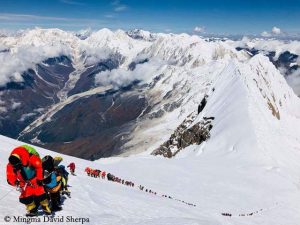Shishapangma, the last take!
A chewing gum is not getting better by chewing it endlessly. There must come a time to spit it out. Stories are a similar ballgame. At a certain moment everything has been devoured a 1000 times. Then you should have the courage to draw a line under it before it becomes a never ending story, which is still only annoying. This will be my last blog post on the avalanche on Shishapangma which happened on next Saturday, exactly two years ago. Maybe not yet everything is said, but in my view it’s enough to close the chapter – and hopefully learn from it.
False impression
It was good that Martin Maier – as reported – kicked off the debate with his interview with the German magazine “Bergsteiger”. Now we have a fairly accurate idea of what really happened at that time, and in some details it defers from what had been previously reported. He wanted to correct this false impression, Martin said in a TV documentary of the German broadcaster “Bayerischer Rundfunk” (BR) on the events on Shishapangma in 2014, “because things that were said have been published somewhere and are accepted by the people as true and as a fact.”
The avalanche had killed the German Sebastian Haag and the Italian Andrea Zambaldi. Like the two, Maier had been swept down the slope 600 meters deep but unlike his climbing partners he had remained lying on the snow surface. In the end he was able to escape, seriously injured, by his own strength to the high camp. Benedikt Boehm and the Swiss Ueli Steck, who had had a lucky escape from the accident, had seen no possibility to traverse to the avalanche cone and had already descended when Martin reached the high camp.
Boehm: “I’m sorry”
Maier proved with pictures that had been taken with a high resolution camera from Base Camp: It was not Basti Haag who did the trail-breaking when the avalanche swept down – as Benedikt Boehm later said in various interviews – but Boehm himself. After long hesitation, Benedikt commented in the BR documentary for the first time on the accusation that he possibly had wanted to blame Haag for the accident. “If it has been understood this way, I’m very, very sorry,” Benedikt said. “It was never my intention to accuse anyone of having triggered the avalanche. Even if a single foot was decisive for what happened, it’s completely irrelevant, because we five had made a joint decision to go up there, of our own accord and of our own risk.” However, Boehm didn’t say why he had not corrected his first statements earlier – as Maier, according to his own words, had repeatedly asked him to do.
“Worst moment”
Also new was the information that Boehm and Steck had recognized from above that one of three other climbers was lying on the snow. “We have seen a colored dot,” Ueli told BR. “There was someone lying out there, you could see that. First he was moving, then he stopped and just lay in the snow.” Due to the great danger of avalanches, Boehm and Steck had decided not to traverse into the slope. “For me it was the worst thing I have ever experienced”, said Ueli. “You see someone down there, and you cannot get there.” In the BR film also Boehm described the decision to descend as “the worst moment of my life. I later did not want to go into detail because this story is so deep inside me. But in retrospect this was a mistake.”
“Very own responsibility”
He is still blaming himself for not having traversed to the avalanche cone to help Martin, Ueli Steck writes on his website under the headline “My principles on the mountain”: “I thank him for not reproaching me for that. I’m going to use the experience of this accident for similar decisions – which hopefully will never be necessary.” However, accidents like the avalanche on Shishapangma cannot be completely ruled out. “Mountaineering is one of the few activities that are not fully regulated, and thus each individual is allowed to determine the risks he is willing to take,” Ueli wrote. “But freedom also means responsibility. We all know that in the end we have to bear our very own responsibility for the risks of this beautiful sport.”
And what else can we learn from the debate about the avalanche on Shishapangma? One should stick with the truth, says Martin Maier. Absolutely!










